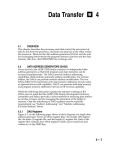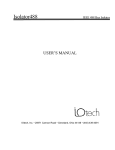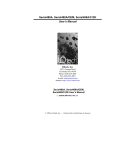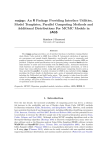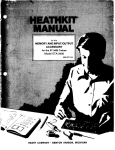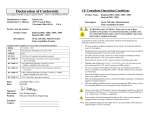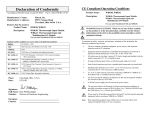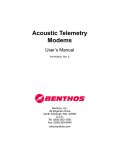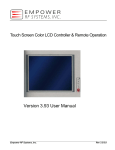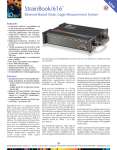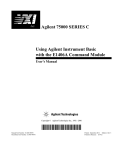Download Micro488/p User`s Manual
Transcript
Micro488/p User’s Manual the smart approach to instrumentation ™ IOtech, Inc. 25971 Cannon Road Cleveland, OH 44146-1833 Phone: (440) 439-4091 Fax: (440) 439-4093 E-mail (Product Information): [email protected] E-mail (Technical Support): [email protected] Internet: www.iotech.com Micro488/p User’s Manual p/n © 1992 by IOtech, Inc. 223-0901 Rev. 2.0 October 2002 Printing Revised per EO # 1634R1 ii Warranty Information Your IOtech warranty is as stated on the product warranty card. You may contact IOtech by phone, fax machine, or e-mail in regard to warranty-related issues. Phone: (440) 439-4091, fax: (440) 439-4093, e-mail: [email protected] Limitation of Liability IOtech, Inc. cannot be held liable for any damages resulting from the use or misuse of this product. Copyright, Trademark, and Licensing Notice All IOtech documentation, software, and hardware are copyright with all rights reserved. No part of this product may be copied, reproduced or transmitted by any mechanical, photographic, electronic, or other method without IOtech’s prior written consent. IOtech product names are trademarked; other product names, as applicable, are trademarks of their respective holders. All supplied IOtech software (including miscellaneous support files, drivers, and sample programs) may only be used on one installation. You may make archival backup copies. FCC Statement IOtech devices emit radio frequency energy in levels compliant with Federal Communications Commission rules (Part 15) for Class A devices. If necessary, refer to the FCC booklet How To Identify and Resolve Radio-TV Interference Problems (stock # 004-000-00345-4) which is available from the U.S. Government Printing Office, Washington, D.C. 20402. CE Notice Many IOtech products carry the CE marker indicating they comply with the safety and emissions standards of the European Community. As applicable, we ship these products with a Declaration of Conformity stating which specifications and operating conditions apply. Warnings, Cautions, Notes, and Tips Refer all service to qualified personnel. This caution symbol warns of possible personal injury or equipment damage under noted conditions. Follow all safety standards of professional practice and the recommendations in this manual. Using this equipment in ways other than described in this manual can present serious safety hazards or cause equipment damage. This ESD caution symbol urges proper handling of equipment or components sensitive to damage from electrostatic discharge. Proper handling guidelines include the use of grounded anti-static mats and wrist straps, ESD-protective bags and cartons, and related procedures. Specifications and Calibration Specifications are subject to change without notice. Significant changes will be addressed in an addendum or revision to the manual. As applicable, IOtech calibrates its hardware to published specifications. Periodic hardware calibration is not covered under the warranty and must be performed by qualified personnel as specified in this manual. Improper calibration procedures may void the warranty. Quality Notice IOtech has maintained ISO 9001 certification since 1996. Prior to shipment, we thoroughly test our products and review our documentation to assure the highest quality in all aspects. In a spirit of continuous improvement, IOtech welcomes your suggestions. iii iv Contents 1 Introduction 1.1 1.2 1.3 1.4 2 Getting Started 2.1 2.2 2.3 2.4 2.5 2.6 2.7 3 Description …… 1-1 Available Accessories …… 1-1 Specifications …… 1-2 Abbreviations …… 1-3 Inspection …… 2-1 Serial Coonfiguration …… 2-1 Serial Signal Descriptions …… 2-2 Serial Cable Wiring …… 2-4 Hardware Installation …… 2-4 Is Anyone Out There? …… 2-5 Programming the Micro488/p …… 2-5 Command Descriptions 3.1 Introduction…… 3-1 3.2 Command Description Format …… 3-2 3.3 The Commands …… 3-5 Appendices A – Micro488/p Command Summary B – Character Codes and IEEE Multiline Messages C – Sample Initialiazation Program Micro488/p, Contents 09-26-02 v vi 09-26-02 Micro488/p Introduction 1.1 Description The Micro488/p Bus Controller converts a host RS-232 computer into an IEEE 488 bus talker, listener, and controller. It provides the basic IEEE 488-1978 bus implementation required for a system controller. The Micro488/p may be located up to fifty feet from the host and may control as many as eight IEEE 488 bus instruments. The Micro488/p interprets simple high level commands sent from the computer's serial port and performs the necessary, and usually complex, bus control and handshaking. The commands and protocol are similar to those used by the Hewlett Packard HP-85 computer. 1.2 Available Accessories Available accessories for the Micro488/p include: CA-7-1 1.5 foot IEEE 488 Cable. CA-7-2 6 foot IEEE 488 Cable. CA-7-3 6 foot shielded IEEE 488 Cable. CA-7-4 6 foot reverse entry IEEE 488 Cable. CA-35 Cable Set; includes one IBM PC/XT/PS2 to Micro488/p RS-232 Cable and one IBM AT to Micro488/p RS-232 Cable. CN-20 Right Angle IEEE 488 adapter, male and female. CN-22 IEEE 488 Multi-tap bus strip, four female connectors in parallel. CN-23 IEEE 488 panel mount feed-through connector, male and female. ABC488 IEEE 488 ABC switch. Micro488/p, Introduction 09-26-02 1-1 1.3 Specifications IEEE 488-1978 Implementation: C1, C2, C3, C4 and C28 controller subsets. Terminators: Selectable CR, LF, LF-CR and CR-LF with EOI. Connector: Standard IEEE 488 connector with metric studs. Serial Interface EIA RS-232C: AB, BA, BB, CA, CB. Character Set: Asynchronous bit serial. Output Voltage: 5 volts min. (RS-232C). Input Voltage: 3 volts min.; 15v max. Baud Rate: Selectable 300, 1200, 2400, 4800, 9600, and 19200. Data Format: 8 data bits; 1 or 2 stop bits, no parity. Duplex: Full with Echo/No Echo. Serial Control: Selectable CTS/RTS or XON/XOFF. Terminators: Selectable CR, LF, LF-CR and CR-LF. Connector: 25-pin Sub-D male. RS-232C DCE Configured. General Data Buffer: 120 character input buffer. Power: Draws less than 5mA from the DTR or DSR serial lines on the host computer. Max. Dimensions: 50mm x 60mm x 25mm (2" x 2.3" x 0.9"). Weight: 51.2 grams (1.8 oz). Environment: 0° to 50°C; 0 to 90% R.H. non-condensing. Controls: All settings auto or software configurable. Note: Specifications subject to change without notice. 1-2 09-26-02 Micro488/p, Introduction 1.4 Abbreviations The following IEEE 488 abbreviations are used throughout this manual: addr n IEEE bus address "n" ATN Attention line CR Carriage Return data Data String DCL Device Clear GET Group Execute Trigger GTL Go To Local LAG Listen Address Group LF Line Feed LLO Local Lock Out MLA My Listen Address MTA My Talk Address REN Remote Enable SDC Selected Device Clear SPD Serial Poll Disable SPE Serial Poll Enable SRQ Service Request TA Talker Active TAD Talker Address term Terminator UNL Unlisten UNT Untalk * Unasserted Micro488/p, Introduction 09-26-02 1-3 Notes: 1-4 09-26-02 Micro488/p, Introduction Getting Started 2.1 Inspection The Micro488/p was carefully inspected, both mechanically and electrically, prior to shipment. When you receive the interface, carefully unpack all items from the shipping carton and check for any obvious signs of physical damage which may have occurred during shipment. Immediately report any such damage found to the shipping agent. Remember to retain all shipping materials in the event that shipment back to the factory becomes necessary. Every Micro488/p is shipped with the following.... • • 2.2 Micro488/p IEEE488 Bus Controller Micro488/p User’s Manual, p/n 232-0901 Serial Configuration Some of the Micro488/p serial communication parameters are pre-configured, and can not be changed. The following list describes the parameters which are fixed and, therefore, can not be changed: Parameter Data Bits Stop Bits Parity Receive Terminator Setting 8 Bit ASCII 1 or 2 None CR The rest of the parameters are configured through software, after power on. The following is a list of the software-configurable parameters: Parameter Baud Rate Duplex Transmit Terminator Handshaking Getting Started Setting 300, 1200, 2400, 4800, 9600, 19200 Full with echo/no-echo LF, CR, LF-CR, CR-LF XON/XOFF or CTS/RTS 09-26-02 2-1 2.3 Serial Signal Descriptions The Micro488/p serial connector is configured as DCE type equipment for RS-232 communications. This means the Micro488/p always transmits data on Pin 3 and always receives data on Pin 2. Note that the Micro488/p is equipped with a standard DB-25S connector and requires a standard DB-25P mating connector. Refer to the following figure and table to understand the relationship of the Micro488/p connector’s pins and the associated RS-232 signals. Section 2.4 of this document includes wiring information for making your own cables. Micro488p Serial Connector Pinout The following table idetifies the above connector pins in regard to signal name and I/O type. 2-2 09-26-02 Getting Started Micro/488p Serial Connection Pin Signal Name I/O Function 2 RxD Receive Data Input Accepts serial data sent by the RS-232 host. The signal level is low true. 3 TxD Transmit Data Output Transmits serial data to the RS-232 host. The signal level is low true. 4 CTS Clear To Send Input The CTS input is used as a hardware handshake line to prevent the Micro488/p from transmitting serial data when the RS-232 host is not ready to accept it. When RTS/CTS handshake is selected, the Micro488/p will not transmit data out TxD while this line is un-asserted (low). If XON/XOFF handshake is selected, the CTS line is not tested to determine if it can transmit data. 5 RTS Request To Send Output The RTS output is used as a hardware handshake line to prevent the RS-232 host from transmitting serial data if the Micro488/p is not ready to accept it. 6 DSR Data Set Ready Input This pin is used to provide power for the Micro488/p if the DTR pin is in its false (LOW) state, this pin must be in its true (HIGH) state in order for the Micro488/p to operate properly. 7 Gnd Ground N/A This pin sets the ground reference point for the other RS-232 inputs and outputs. 8 DCD Data Carrier Detect Output The function of this pin is similar to the CTS pin. This pin is tied internally to its true (HIGH) state. 20 DTR DataTerminal Ready Input Used to provide power for the Micro488/p when the DSR pin (pin 6) is in its false (LOW) state. Note that the DTR pin (pin 20) must be in its true (HIGH) state in order for the Micro488/p to operate properly. Getting Started 09-26-02 2-3 2.4 Serial Cable Wiring If a cable was not purchased with the interface, the following diagrams will be helpful in making your own cable. Simple soldering skills and attention to detail will ensure successful construction. IBM PC/XT/PS2 to Micro488/p IBM AT to Micro488/p DB25, Female DB25, Male DB9, Female DB25, Male TXD 2 2 TXD DCD 1 8 DCD RXD 3 3 RXD RXD 2 3 RXD RTS 4 4 RTS TXD 3 2 TXD CTS 5 5 CTS DTR 4 20 DTR DSR 6 6 DSR GND 5 7 GND GND 7 7 GND DSR 6 6 DSR DCD 8 8 DCD RTS 7 4 RTS DTR 20 20 DTR CTS 8 5 CTS Two Scenarios for Making an Interface Cable (RS-232) 2.5 Hardware Installation Installation of the Micro488/p consists of plugging the device into an available serial port on the host computer. 2-4 09-26-02 Getting Started 2.6 Is Anyone Out There? In order to properly operate the Micro488/p, the DTR and DSR lines on the COM port must be initialized first. Usually this can be accomplished by closing and then opening the serial port. Appendix C includes a Sample Initialization Program. Once the DTR and DSR ines have been initialized, the next step is to initialize the baud rate to be used with the Micro488/p. This is done by sending the Micro488/p five carriage returns, separated by a 0.1 second delay. Now send the Micro488/p the following command: "I" <CR>. The Micro488/p should respond with the prompt ">" character. Now the IEEE488 bus is initialized, and the Micro488/p ready for operation. 2.7 Programming the Micro488/p The next step involves writing a simple dumb terminal program to communicate with the Micro488/p. The dumb terminal program is written in QuickBASIC for any IBM PC compatable computer, and allows simple communication with IEEE 488 devices connected to the Micro488/p. The first task is to open the serial port to which the Micro488/p is connected. If the Micro488/p is connected to serial port 1, then the following line will open that serial port with the following parameters: Baud Rate - 19200 Parity - NONE Data Bits - 8 Stop Bits - 2 OPEN "COM1:19200,N,8,2,cs,ds" FOR RANDOM AS #1 Next, wait a moment for the Micro488/p's power supply to stabilize. t = TIMER DO WHILE t + .1 > TIMER LOOP Getting Started 09-26-02 2-5 Now that the Micro488/p is powered on, send it five carriage returns for the buad rate detection circuitry to set the internal baud rate. Place a short time delay between the characters to ensure that the proper baud rate will be detected. FOR i = 1 TO 5 PRINT #1, CHR$(13); t = TIMER DO WHILE t + .2 > TIMER LOOP NEXT i Next, initialize the Micro488/p with the following command: PRINT #1, "I" Now, set up the Micro488/p with the following parameters: Serial echo - OFF Hardware Handshake - ON XON/XOFF handshaking - OFF Serial terminator - CARRIAGE RETURN IEEE bus terminator - CARRIAGE RETURN, LINE FEED PRINT #1, "EC;0" PRINT #1, "H;1" PRINT #1, "X;0" PRINT #1, "TC;2" PRINT #1, "TB;4" After a short delay for command processing, input any garbage characters that may be in the PC's serial input buffer. t = TIMER DO WHILE t + .5 > TIMER LOOP a$ = INPUT$(LOC(1), #1) 2-6 09-26-02 Getting Started Now the Micro488/p is ready for operation. Simply set up an infinite loop to check for user keypresses and to look for serial data in the PC's serial input buffer. PRINT "Ready!" DO IF LOC(1) THEN PRINT INPUT$(LOC(1), 1); k$ = INKEY$ PRINT #1, k$; PRINT k$; LOOP 'If anything is in the 'PC's serial input 'buffer 'print it to the screen. 'Get key press 'Send it to the 'Micro488/p 'Echo keypress to screen The following is a complete listing of 'DUMBTERM.BAS" 'Micro488/p Dumb Terminal Program 'Copyright 1992 IOtech Inc. CLS PRINT "Initializing..." OPEN "COM1:19200,N,8,2,cs,ds" FOR RANDOM AS #1 t = TIMER DO WHILE t + .1 > TIMER LOOP FOR i = 1 TO 5 PRINT #1, CHR$(13); t = TIMER DO WHILE t + .2 > TIMER LOOP NEXT i PRINT #1, "I" PRINT #1, "EC;0" PRINT #1, "H;1" PRINT #1, "X;0" PRINT #1, "TC;2" PRINT #1, "TB;4" t = TIMER Getting Started 09-26-02 2-7 DO WHILE t + .5 > TIMER LOOP a$ = INPUT$(LOC(1), #1) PRINT "Ready!" DO IF LOC(1) THEN PRINT INPUT$(LOC(1), 1); k$ = INKEY$ PRINT #1, k$; PRINT k$; LOOP Section 3 contains detailed command descriptions which are applicable Micro488/p. 2-8 09-26-02 Getting Started Command Descriptions 3.1 Introduction This section contains detailed descriptions of each of the low and high-level commands available for the Micro488/p. There are two types of commands: bus commands and system commands. Bus commands communicate with the IEEE 488 bus. System commands configure or request information from the Micro488/p. Bus Commands: A C C;<addr> EO;n EN EN;<addr> L L;<addr> LL O;cmd$ OA;<addr>;cmd$ RE RE;<addr> RS SP;<addr>; SQ TR TR;<addr> /A /L;<addr> /ML /MT /T;<addr> /UL /UT Command Descriptions (ABORT I/O) (DEVICE CLEAR) (DEVICE CLEAR w/device specified) (EOI ENABLE/DISABLE) (ENTER) (ENTER w/device specified) (LOCAL) (LOCAL w/device specified) (LOCAL LOCKOUT) (OUTPUT) (OUTPUT w/device specified ) (REMOTE) (REMOTE w/device specified) (RESUME) (SERIAL POLL) (SRQ CHECK) (TRIGGER) (TRIGGER w/device specified) (LOW-LEVEL COMMAND) (SEND LISTEN ADDRESS w/device specified) (LOW-LEVEL COMMAND) (LOW-LEVEL COMMAND) (SEND TALK ADDRESS w/device specified) (LOW-LEVEL COMMAND) (LOW-LEVEL COMMAND) 09-27-02 3-1 System Commands: <CTRL> A <CTRL> Q <CTRL> S EC;n H;n I TB;n TC;n X;n 3.2 (ESCAPE) (XON) (XOFF) (ECHO) (HARDWARE HANDSHAKE) (INIT) (IEEE BUS TERMINATOR) (SERIAL TERMINATOR) (XOFF/XON) Command Description Format Each command description includes syntax, response, bus states, and examples. 3.2.1 Syntax The syntax portion of the command description describes the proper command syntax which must be sent to the Micro488/p using the IBM BASIC PRINT# command, or its equivalent in other languages, to the COM port. The following conventions apply throughout the syntax descriptions: • The Micro488/p is case insensitive; i.e., system commands may be in upper or lower case. • Commands to an individual IEEE device must conform to the device's particular syntax. • Items in lower case, such as addr or n, represent parameters which must be substituted with an appropriate value. • Numeric parameters (those that are given as numbers) are decimal unless preceded by &H, in which case they considered to be hexadecimal. For example, 100 is decimal 100, &H64 is hexadecimal 64 which equals decimal 100, &HFF is decimal 255, and 0FF is invalid because F is not a valid decimal digit. Note: Bus addresses are the only exception to the numeric parameters rule. • Bus addresses, both primary and secondary, must be specified as two-digit decimal numbers. Hexadecimal bus addresses are not allowed. 3-2 09-27-02 Command Descriptions 3.2.1.1 Bus Addressing The following conventions apply to bus addressing: addr An IEEE bus address in the range from 00 through 30. cmd$ An arbitrary command string which is sent to the particular IEEE device being addressed. CR The carriage return character ($13, $&H0D). LF The line feed character ($10, $&H0A). 3.2.1.2 Terminators The following conventions apply to terminators: term Any single character, specified as CR, LF, 'X', as described previously; part of terminator sequence used to mark the end of lines of data and commands. EOI The IEEE bus End-Or-Identify signal; when asserted during the transfer of a character, EOI signals that character as the last in the transfer. On input, EOI, if specified, causes the input to stop. On output, EOI causes the bus EOI signal to be asserted during transmission of the last character transferred. Command Descriptions 09-27-02 3-3 3.2.2 Response This portion of the command description describes the response that the user's program should read from the serial host's COM port after sending the command. If a response is provided, it must be read to maintain proper program seqence. 3.2.3 Bus States This portion of the command description describes the bus command and data transfers using IEEE bus mnemonics as listed in the following table. Bus States DIO lines 8 ATN data DCL GET GTL IFC LAG LLO MLA MTA REN SDC SPD SPE SRQ TAG UNL UNT Attention Data String Device Clear Group Execute Trigger Go To Local Interface Clear Listen Address Group Local Lock Out My Listen Address My Talk Address Remote Enable Selected Device Clear Serial Poll Disable Serial Poll Enable Service Request Talker Address Group Unlisten Untalk 7 6 5 4 3 2 1 x 0 0 1 0 1 0 0 x 0 0 0 1 0 0 0 x 0 0 0 0 0 0 1 x 0 1 a d d r n x 0 0 1 0 0 0 1 x 0 1 a d d r n x 1 0 a d d r n x 0 0 0 0 1 0 0 x 0 0 1 1 0 0 1 x 0 0 1 1 0 0 0 x 1 0 a d d r n x 0 1 1 1 1 1 1 x 1 0 1 1 1 1 1 x = "don't care" addrn = IEEE bus address “n” 3-4 09-27-02 Command Descriptions If a command is preceded by an asterisk, it is unasserted. For example, *REN states that the remote enable line is unasserted; REN without the asterisk states that the line is asserted. 3.2.4 Examples This portion of the command description includes programming examples written in BASIC. 3.3 The Commands Command descriptions, relevant to Micro488/p, now follow. Command Descriptions 09-27-02 3-5 /A The /A command is a low level IEEE command which asserts the attention line. After completion of this command, the Micro488/p is left in the controller active state. SYNTAX /A RESPONSE None BUS STATES ATN EXAMPLE PRINT#1,"/A" /L The /L command is a low level IEEE command which sends the LAG command to the specified device. After completion of this command, the Micro488/p is left in the controller active state. SYNTAX /L RESPONSE None BUS STATES ATN,LAG EXAMPLE PRINT#1,"/L;10" 3-6 09-27-02 Send LAG10 on the IEEE bus. Command Descriptions /ML The /ML command is a low level IEEE command which places the Micro488/p in the listen state. After completion of this command, the Micro488/p is ready to listen as soon as the RESUME (RS) command is issued. SYNTAX /ML RESPONSE None BUS STATES ATN EXAMPLE PRINT#1,"/ML" /MT The /MT command is a low level IEEE command which places the Micro488/p in the talk state. After completion of this command, the Micro488/p is ready to talk as soon as the RESUME (RS) command is issued. SYNTAX /MT RESPONSE None BUS STATES ATN,UNT EXAMPLE PRINT#1,"/MT" Command Descriptions 09-27-02 3-7 /T The /T command is a low level IEEE command which issues the talk command to the specified IEEE device. SYNTAX /T;addr RESPONSE None BUS STATES ATN,TAG EXAMPLE PRINT#1,"/T;10" Issue TAG to device 10. /UL The /UL command is a low level IEEE command which sends the UNL command to the IEEE bus. This command instructs all devices on the IEEE bus to get off the IEEE bus. SYNTAX /UL RESPONSE None BUS STATES ATN,UNL EXAMPLE PRINT#1,"/UL" 3-8 09-27-02 Command Descriptions /UT The /UT command is a low level IEEE command which sends the UNT command to the IEEE bus. This command instructs all devices on the IEEE bus to get off the IEEE bus. SYNTAX /UT RESPONSE None BUS STATES ATN,UNT EXAMPLE PRINT#1,"/UT" A ABORT I/O The ABORT I/O command causes the Interface Clear (IFC) bus management line to be pulsed. By asserting IFC, the Micro488/p regains control of the bus even if one of the devices has locked it up during a data transfer. ABORT I/O forces all IEEE bus device interfaces into a quiescent idle state. SYNTAX A RESPONSE None BUS STATES *REN, IFC, *IFC, ATN, REN EXAMPLE PRINT#1,"A" Command Descriptions 09-27-02 3-9 C DEVICE CLEAR The DEVICE CLEAR command causes the Device Clear (DCL) bus command to be issued by the Micro488/p. If the optional addresses are included, the Selected Device Clear (SDC) command is issued to the specified devices. IEEE 488 bus devices which receive a Device Clear or Selected Device Clear command normally reset to their power-on state. SYNTAX C[;addr] RESPONSE None BUS STATES ATN, DCL ATN, UNL,UNT,LAG,SDC EXAMPLES PRINT #1,"C" PRINT #1,"C;10" (all devices) (selected devices) Issue a Device Clear to all devices. Issue a Selected Device Clear to device 10. EC ECHO The system command ECHO instructs the Micro488/p to either enable, or disable serial echo. SYNTAX EC;n n = 1, enable serial echo. n = 0, disable serial echo. RESPONSE None BUS STATES None EXAMPLE PRINT#1,"EC;1" 3-10 09-27-02 Enable serial echo. Command Descriptions EN ENTER The ENTER command reads data from the IEEE bus. If a device address is specified, that device is addressed to talk. If no address is specified, the Micro488/p must already be configured to receive data as a result of an immediately preceding ENTER command. The Micro488/p hangs the bus if no device is present to provide the data. From either mode (addressed or unaddressed), the Micro488/p inputs data from the IEEE bus and sends it to serial port until one of the following conditions is met: 1. 2. 3. A terminator character is received from the IEEE device that is talking. An EOI is received with the data from the IEEE device that is talking. An Escape command is received from the host computer via the serial port. SYNTAX EN[;addr] addr is the IEEE bus device address. RESPONSE Device-dependent data. The response ends when the IEEE bus input terminator is detected and the serial output terminators are appended to the returned data. BUS STATES ATN,UNL,TAG,*ATN Micro488/p is in the listener active state, and IEEE device is in the talker active state. EXAMPLES PRINT#1,"EN;16" INPUT#1,A$ PRINT#1,"EN;16" LINE INPUT#1,A$ Command Descriptions 09-27-02 Read data from device 16. Read an entire line of data from device 16 even if it contains commas or other punctuation. 3-11 <CTRL>A ESCAPE The system command ESCAPE unlocks the Micro488/p from an inappropriate command, such as a command requesting data from a nonexistent device. When the ESCAPE command is received, the serial handshake line (RTS) is un-asserted. It is asserted when the Micro488/p is capable of buffering commands. If XON/XOFF handshake is selected, the software handshake state is not modified. Issuing the ESCAPE command clears the serial input (pending commands) and causes the Micro488/p to wait for new commands. SYNTAX <CTRL> A or CHR$(1) RESPONSE None BUS STATES None EXAMPLE PRINT #1, CHR$(1) H HARDWARE HANDSHAKE The system command HARDWARE HANDSHAKE enables or disables hardware (CTS/RTS) handshake. SYNTAX H;n n = 0, disable hardware handshake. n = 1, enable hardware handshake. RESPONSE None BUS STATES None EXAMPLE PRINT#1,"H;1" 3-12 09-27-02 Enable hardware handshake. Command Descriptions TB IEEE BUS TERMINATOR The IEEE BUS TERMINATOR command is used to select the IEEE bus terminator for reads from the IEEE bus. The selected terminator signifies the end of an ENTER sequence. The available terminators are: 1 - LF 2 - CR 3 - LF-CR 4 - CR-LF SYNTAX TB;n n is one of the available terminator types. RESPONSE None BUS STATES None EXAMPLE PRINT #1, "TB;1" Command Descriptions 09-27-02 Select LF as an IEEE bus terminator. 3-13 I INIT The system command INIT provides a warm start of the interface. Issuing the INIT command clears the serial input (pending commands) and output (pending data) buffers and re-initializes the internal IEEE controller hardware. SYNTAX I RESPONSE None BUS STATES IFC, REN, *IFC, ATN, *REN, REN EXAMPLE PRINT#1,"I" L LOCAL The LOCAL command, without optional address, causes the Micro488/p to un-assert the Remote Enable line causing devices on the bus to return to manual operation. With the address specified, the bus device is placed in the local mode by the Go To Local (GTL) bus command. SYNTAX RESPONSE BUS STATES L [;addr] None *REM unaddressed. ATN, UNL, UNT, LAG, GTL addressed. EXAMPLES PRINT#1,"L" PRINT #1,"L;16" 3-14 09-27-02 Un-assert the REN Line. Cause device 16 to go to local. Command Descriptions LL LOCAL LOCKOUT The LOCAL LOCKOUT command causes the Micro488/p to issue a Local Lockout IEEE bus command which inhibits bus devices that support this command from being controlled manually from their front panels. SYNTAX LL RESPONSE None BUS STATES ATN, LLO EXAMPLES PRINT#1,"LL" Send Local Lockout command. O OUTPUT The OUTPUT command sends data to the IEEE bus. The Remote Enable line is first asserted, then, if a device address is specified, that device is addressed to listen. If an address is not specified, the Micro488/p must already be configured to send data as a result of an immediately preceding OUTPUT command. SYNTAX O;cmd$ unaddressed. OA;addr;cmd$ addressed. addr is a bus device address. cmd$ is a string of characters to OUTPUT terminated by the serial terminator(s). RESPONSE None BUS STATES REN , *ATN, cmd$ unaddressed. ATN, UNL, UNT, LAG, GTL, data addressed. EXAMPLES PRINT#1,"OA;22;R0C0T1X" Send "R0C0T1X" to device 22. PRINT#1,"O;XYZ" Send device 22 "XYZ". Command Descriptions 09-27-02 3-15 RE REMOTE The REMOTE command asserts the Remote Enable (REN) bus management line. If the optional bus address is specified, then REMOTE also addresses the device to listen, placing it in the Remote addressed state. SYNTAX RE [;addr] RESPONSE None BUS STATES REN unaddressed. REN, ATN, UNL. UNT. LAG addressed. EXAMPLE PRINT #1,"RE" RS Assert Remote Enable. RESUME The RESUME command un-asserts the Attention (ATN) bus signal removing the Micro488/p from the active controller state and allowing transfers to take place between two peripheral devices. SYNTAX RS RESPONSE None BUS STATES *ATN EXAMPLE PRINT#1,"RS" 3-16 09-27-02 Un-assert ATTENTION line. Command Descriptions SP SERIAL POLL The SERIAL POLL command performs a Serial Poll of the bus device specified and responds with a number from 0 to 255 representing the decimal equivalent of the eight-bit device response. If rsv (DIO7, decimal value 64) is set, then that device is signaling that it requires service. Serial Polls are normally performed in response to assertion of the Service Request (SRQ) bus signal by some bus device. SYNTAX SP; addr RESPONSE 0 to 255 BUS STATES ATN, UNL, TAG, SPE, *ATN, data, ATN, SPD, UNT EXAMPLES PRINT#1,"SP 16" INPUT#1,SPSTAT TC Serial Poll device 16. Receive the Spoll status. SERIAL TERMINATOR The SERIAL TERMINATOR command sets the end-of-line terminators for input from the serial host. All input from the serial host must be terminated by the selected terminator. During INPUT, the Micro488/p takes the data it receives from the bus device until it detects the LF of other optionally specified input terminating condition. It strips all CR and LF from the input data and appends the serial output terminator CR before sending it to the serial host. The available terminators are: 1 - LF 2 - CR 3 - LF-CR 4 - CR-LF SYNTAX TC;n n is one of the available terminator types. RESPONSE None BUS STATES None EXAMPLES PRINT#1,"TC;2" Command Descriptions 09-27-02 Select CR as the serial output terminator. 3-17 SQ SRQ CHECK The system command SRQ CHECK inquires whether or not the SRQ line on the IEEE bus is currently being asserted. SYNTAX SQ RESPONSE Y SRQ is being asserted. N SRQ is not being asserted. BUS STATES None EXAMPLES PRINT #1, "SQ" INPUT#1,SRQSTAT TR Issue SRQ CHECK command. Receive SRQ status. TRIGGER The TRIGGER command issues a Group Execute Trigger (GET) bus command to the specified device. If no address is specified, then GET only affects those devices that are already in the listen state as a result of a previous OUTPUT command. SYNTAX TR[;addr] RESPONSE None BUS STATES ATN, GET unaddressed. ATN, UNL,UNT, LAG, GET addressed. EXAMPLES PRINT#1,"TR;16" 3-18 09-27-02 Issue Group Execute Trigger to device 16. Command Descriptions X XOFF/XON The system command XOFF/XON enables or disables XON/XOFF handshaking. SYNTAX X;n n = 0, disable XON/XOFF handshaking. n = 1, enable XON/XOFF handshaking. RESPONSE None BUS STATES None EXAMPLE PRINT #1, "X;1" <CTRL>S Enable XON/XOFF handshaking. XOFF The system command XOFF temporarily inhibits serial transmission from the Micro488/p. SYNTAX <CTRL> S or CHR$(19) RESPONSE None BUS STATES None EXAMPLE PRINT #1, CHR$(19) Command Descriptions 09-27-02 3-19 <CTRL>Q XON The system command XON restarts serial transmission from the Micro488/p following reception of the XOFF command. SYNTAX <CTRL> Q CHR$(17) RESPONSE None BUS STATES None EXAMPLE PRINT #1, CHR$(17) 3-20 09-27-02 Command Descriptions Appendix A Micro488/p Command Summary Command Code Description Page /A /A Asserts the attention line; leaves Micro488/p in the controller active state. 3-6 /L /L Sends the LAG command to the specified device; leaves Micro488/p in the controller active state. 3-6 /ML /ML Places the Micro488/p in the listen state on RESUME (RS). 3-7 /MT /MT Places the Micro488/p in the talk state on RESUME (RS). 3-7 /T /T;addr Issues the talk command to the specified IEEE device. 3-8 /UL /UL Sends the UNL command to the IEEE bus; instructs all devices on the IEEE bus to get off the IEEE bus. 3-8 /UT /UT Sends the UNT command to the IEEE bus; instructs all devices on the IEEE bus to get off the IEEE bus. 3-9 ABORT I/O A Pulses Interface Clear (IFC) bus management line to be pulsed; forces all IEEE bus device interfaces into a quiescent idle state. 3-9 DEVICE CLEAR C[;addr] Instructs Micro488/p to issue Device Clear (DCL) bus command; if optional addresses are included, issues the Selected Device Clear (SDC) command to the specified devices. 3-10 ECHO EC;n Instructs the Micro488/p to enable or disable serial echo. 3-10 ENTER ENTER[;addr] Reads data from the IEEE bus and sends it to serial port; a terminator character, an EOI, or an ESCAPE command terminates data input/output. 3-11 ESCAPE <CTRL> A CHR$(1) Unlocks the Micro488/p from an inappropriate command; clears the serial input (pending commands) and instructs Micro488/p to wait for new commands. 3-12 HARDWARE HANDSHAKE H;n Enables or disables hardware (CTS/RTS) handshake. 3-12 IEEE BUS TERMINATOR TB;n Selects the IEEE bus terminator for reads from the IEEE bus; selected terminator signifies the end of an ENTER sequence. 3-13 INIT I Provides a warm start of the interface; clears the serial input (pending commands) and output (pending data) buffers and re-initializes the internal IEEE controller hardware. 3-14 Appendix A, Micro488/p Command Summary 09-26-02 A-1 Command Code Description LOCAL L[;addr] Without optional address, instructs the Micro488/p to un-assert the Remote Enable line causing devices on the bus to return to manual operation; with optional address, places bus device in the local mode by the Go To Local (GTL) bus command. 3-14 LOCAL LOCKOUT LL Instructs the Micro488/p to issue a Local Lockout IEEE bus command. 3-15 OUTPUT O;cmd$ O;addr;cmd$ Sends data to the IEEE bus. 3-15 REMOTE RE[;addr] Asserts the Remote Enable (REN) bus management line. 3-16 RESUME RS Un-asserts the Attention (ATN) bus signal; removes the Micro488/p from the active controller state and allows transfers between two peripheral devices. 3-16 SERIAL POLL SP;addr Performs a serial poll of the bus device specified; responds with a number from 0 to 255 representing the decimal equivalent of the eightbit device response. 3-17 SERIAL TERMINATOR TC;n Sets the end-of-line terminators for input from the serial host. 3-17 SRQ CHECK SQ Inquires whether or not the SRQ line on the IEEE bus is currently being asserted. 3-18 TRIGGER TR[;addr] Issues a Group Execute Trigger (GET) bus command to the specified device; if no address is specified, then GET affects those devices already in the listen state. 3-18 XOFF/XON X;n Enables or disables XON/XOFF handshaking. 3-19 XOFF <CTRL>S CHR$1(9) Temporarily inhibits serial transmission from the Micro488/p. 3-19 XON <CTRL>Q CHR$1(17) Restarts serial transmission from the Micro488/p. 3-20 A-2 09-26-02 Page Appendix A, Micro488/p Command Summary Appendix B $00 0 NUL $01 Character Codes and IEEE Multiline Messages $10 1 $11 SOH GTL $02 2 ETX EOT ENQ ACK BEL BS DCL $15 PPU $16 GTL $17 $18 9 10 VT 29 $1E SO 30 13 $2E $1F 14 $2F US / 15 ACG UCG ACG = Addressed Command Group UCG = Universal Command Group LAG = Listen Address Group 12 $4D 27 $5C 28 $5D 29 $5E N 63 14 $4F 30 $5F O 15 LAG 109 SCG $6E SCG $7D _ SCG $7E TAG 126 ~ 111 SCG $7F o SCG 125 } 110 SCG $6F 124 | N 95 31 SCG $7C m 94 123 { 108 SCG $6D ^ 79 SCG $7B l 93 122 z 107 SCG $6C ] 78 SCG $7A k 92 121 y 106 SCG $6B \ 77 13 $4E ? 31 76 SCG $79 j 91 120 x 105 SCG $6A [ M 62 30 $3F 26 $5B SCG $78 i 90 119 w 104 SCG $69 Z 75 11 $4C > 47 25 $5A L 61 29 $3E . 31 10 $4B = 46 74 SCG $77 h 89 118 v 103 SCG $68 Y K 60 28 $3D 24 $59 SCG $76 g 88 117 u 102 SCG $67 X 73 09 $4A < 45 23 $58 J 59 27 $3C - RS 15 44 12 $2D 08 $49 ; , GS 14 SI + 72 SCG $75 f 87 116 t 101 SCG $66 W I 58 26 $3B 22 $57 SCG $74 e 86 115 s 100 SCG $65 V 71 07 $48 : 43 21 $56 H 57 25 $3A * 11 $2C 06 $47 9 42 70 SCG $73 d 85 114 r 99 SCG $64 U G 56 24 $39 20 $55 F 55 23 $38 ) 10 $2B 05 $46 8 41 09 $2A 54 22 $37 69 SCG $72 c 84 113 q 98 SCG $63 T E 7 40 08 $29 04 $45 6 39 07 $28 53 21 $36 ( 28 $1D CR $0F 06 $27 FS 13 38 19 $54 SCG $71 b 83 112 p 97 SCG $62 S 68 $70 a 82 18 $53 D 5 ' 27 $1C FF $0E 23 26 $1B 20 $35 & 25 SPD $1A 37 05 $26 ESC 12 $0D 22 03 $44 SCG $61 R 67 96 ` 81 17 $52 C 52 $60 Q 66 02 $43 4 % SUB 11 $0C 04 $25 EM LF $0B 21 24 SPE $19 19 $34 16 $51 B 51 80 P 65 01 $42 3 36 $50 A 50 18 $33 $ CAN HT TCT $0A 03 $24 00 $41 2 35 64 @ 49 17 $32 # 20 $40 1 34 02 $23 ETB 8 GET $09 $14 16 $31 " 19 48 0 33 01 $22 SYN 7 $08 18 NAK 6 $07 $13 $30 ! DC4 5 PPC $06 00 $21 DC3 4 SDC $05 17 LLO $12 32 SP DC2 3 $04 $20 DCI STX $03 16 DLE 127 DEL SCG SCG TAG = Talk Address Group SCG = Secondary Command Group Appendix B, Character Codes and IEEE Multiline Messages 09-27-02 B-1 Notes: B-2 Appendix C Sample Initialization Program 'Sample Micro488/p initialization program 'Copyright 1992, IOtech Inc. ' 'This program demonstrates how to initialize the Micro488/p IEEE 'controller using Quick Basic. This program will initialize the 'Micro488/P, and establish IEEE communications. CLS CLOSE 'Close all files, this turns off DTR and DSR. com$ = "COM1:19200,N,8,1,BIN" IeeeOut = FREEFILE IeeeIn = FREEFILE OPEN com$ FOR RANDOM AS #IeeeOut t = TIMER DO WHILE t + .1 > TIMER LOOP FOR i = 1 TO 5 'Open the serial port on COM 1 'Wait for .1 Seconds 'Send 5 carriage returns, with a .1 'second delay seperation. PRINT #IeeeOut, CHR$(13); t = TIMER DO WHILE t + .1 > TIMER LOOP NEXT i PRINT PRINT PRINT PRINT PRINT PRINT LF #IeeeOut, #IeeeOut, #IeeeOut, #IeeeOut, #IeeeOut, #IeeeOut, "I" "EC;0" "H;1" "X;0" "TC;2" "TB;4" t = TIMER DO WHILE t + .5 > TIMER LOOP a$ = INPUT$(LOC(1), #IeeeIn) Appendix C, Sample Initialization Program 'Send Init command 'Turn off serial echo 'Turn on hardware handshake 'Turn off XON/XOFF handshake 'Set serial terminator to CR 'Set IEEE bus terminator to CR 'Wait .5 seconds 'Clear the serial input buffer. 09-27-02 C-1 Notes: C-2












































